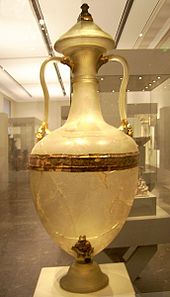Berlin glass amphora from Olbia
The Berlin glass amphora from Olbia is a Hellenistic glass vessel in the form of an amphora , which is now in the Berlin Collection of Antiquities with the inventory number 30219, 254 . It is the largest piece of its kind found and one of the best preserved.
The amphora is considered one of the masterpieces of Hellenistic glassmaking. It is 59.6 cm high, making it the largest preserved glass vessel from ancient times . It is completely bubble free. Today the glass is milky and slightly yellow-whitish. The jar used to be clear and light green in color. It weighs 2.445 kg with its lid and has a diameter of 9.6 cm at the lid and 22.4 cm at the belly. Since glass blowing had not yet been invented, the production process was complicated. The vase was created from two pieces, the wide belly on a high foot and the shoulder with a long neck with a wide mouth. They fit together exactly. The seam is covered with a gilded sheet copper strip decorated with tendrils. However, only one side of the strip has survived. The two parts were also created in different steps. The belly, the wall of which is very thin, was either melted in the mold or lowered onto a half-mold. The bell-shaped foot was also produced, which was then connected to the abdominal part by means of a solid handle. The top is produced in the same way. The shoulder and part of the neck were either poured into a mold or lowered hot on a template. The rest of the neck and the muzzle were connected with a hot stem like the foot and belly, which can be clearly seen from the bulge. The lid is not the original one, which was probably broken and was replaced by a new, slightly overlapping, conical lid in a slightly yellowish clear glass. Due to the complicated manufacturing process, there is an axis shift from the foot to the cover.
Holes have been drilled in both sides of the lower abdominal wall. In these holes there are nozzles in the form of satyrs that hold animal hide from which the liquids from the amphora could flow. Like the decorative strips and other decorative parts, the knob of the lid or the cuffs that cover the connection between the handle and the amphora body, they are made of gold-plated copper sheet. The cuffs on the handles are shaped like masks and maple leaves . The craftsmen adopted the shape from the Panathenaic price amphoras , which were used in this form in the 3rd and 2nd centuries BC. Were made in Athens . It is believed that a wealthy citizen of the city of Olbia , where the piece was later found, commissioned the vase. It is in the second half of the 2nd century BC. Dated. It must have had an effect similar to rock crystal , especially when it was used during feasts in the glow of artificial light .
The magnificent vessel, unique in its shape, is now in the Berlin Collection of Antiquities and is exhibited in the Altes Museum . In 1912, like other antique glass vessels, it came to the Berlin Collection of Antiquities as a gift from Friedrich Ludwig von Gans .
literature
- Gertrud Platz-Horster : The Berlin glass amphora from Olbia. In: Journal of Glass Studies. Volume 37, 1995, ISSN 0075-4250 , pp. 35-50.
- Gertrud Platz-Horster: The glass amphora from Olbia. In: Andreas Scholl , Gertrud Platz-Horster (ed.): The collection of antiques. Old museum. Pergamon Museum. 3rd, completely revised and expanded edition. von Zabern, Mainz 2007, ISBN 978-3-8053-2449-6 , pp. 107-108.
Coordinates: 52 ° 31 '10 " N , 13 ° 23' 54" E

